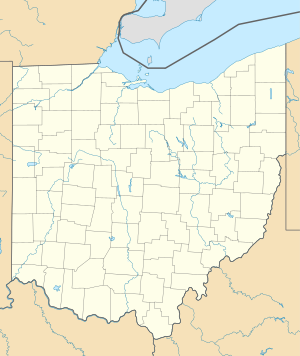McCook Field
This article includes a list of general references, but it lacks sufficient corresponding inline citations. (May 2014) |
| McCook Field | |
|---|---|
Packard-Le Peré LUSAC-11 Biplane at McCook Field, 24 September 1919 | |
| Coordinates | 39°46′33″N 84°11′27″W / 39.77583°N 84.19083°W |
| Type | Aircraft Flight Testing |
| Site information | |
| Controlled by | |
| Site history | |
| Built | 1917 |
| In use | 1917–1927 |
| Battles/wars | World War I |
McCook Field was an airfield and aviation experimentation station in
History
In 1917, anticipating a massive need for military airplanes by the United States during World War I, six Dayton businessmen including Edward A. Deeds formed the Dayton-Wright Company in Dayton, Ohio. In addition to building a factory in Moraine, Ohio, Deeds built an airfield on property he owned in Moraine for use by the company. Deeds was also interested in building a public aviation field along the Great Miami River approximately one mile (1.6 km) north of downtown Dayton, purchasing the property in March 1917. He called it North Field to differentiate it from the South Field in Moraine.
The United States entered the war before he could develop North Field. Deeds sold his interest in the Dayton-Wright Company to become a member of the
McCook Field's flying field was in the flood plain of the Great Miami River between the confluences of that river, the Stillwater River, and the Mad River. (now the present-day Dayton park, Kettering Field, named for Charles F. Kettering) and its structures were located on what was previously the site of the Parkside Homes housing project before its demolition in 2008.[1] Constructed during World War I, it became the location of the Aviation Service's Engineering Division in 1919.
World War I Air Service units assigned to McCook Field were:[2]
- 246th Aero Squadron, November 1917
- Re-designated as Squadron "A", July–August 1918
- 881st Aero Squadron (Repair), February 1918
- Re-designated as Squadron "B", July–August 1918
- Detachment #10, Air Service, Aircraft Production, August 1918-May 1919
- Organized as consolidation of Squadrons "A" and "B"
The field was unusual in that to optimize flight test conditions, it had a smooth-surfaced runway built of macadam and cinders rather than the bumpy grass runways nearly universal at the time. However, to use the prevailing winds, the runway transected the narrow dimension of the tract and ended at a flood levee. It was 1,000 feet (300 m) in length at the beginning and never exceeded 2,000 feet (610 m). A huge sign painted across the front of McCook's main hangar prominently warned arriving pilots: THIS FIELD IS SMALL. USE IT ALL. Urban growth encroached on the space and larger aircraft being developed overtaxed the field's grass surface. Ultimately, the field became too small for its purpose.
The Army had from the start intended at some point to relocate McCook's operations to a permanent home at
Patterson died in 1922, and his son (and successor at NCR),
In March 1923
McCook Field closed concurrent with the opening of the new
Achievements
- Aerial application, or "Crop Dusting"
- Aircraft pressurization
- Airport service vehicles
- Landing lights for aircraft
- The free fall parachute
See also
- List of Training Section Air Service airfields
- Nemeth Parasol
References
![]() This article incorporates public domain material from the Air Force Historical Research Agency
This article incorporates public domain material from the Air Force Historical Research Agency
- ^ Dayton Daily News Archives, May 13, 2014 https://www.libraries.wright.edu/special/ddn_archive/2014/05/13/mccook-field/
- ^ Order of Battle of the United States Land Forces in the First World War, Volume 3, Part 3, Center of Military History, United States Army, 1949 (1988 Reprint)
- March 3, 1923. p. 23. Retrieved March 2, 2021.

